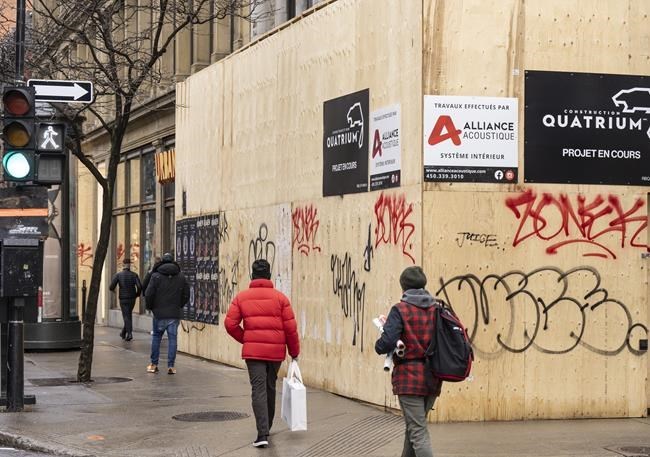MONTREAL — Wellington Street in Montreal's Verdun borough is booming, with cheerful shop facades lining a district bustling with pedestrians.
With a commercial vacancy rate the local business association pegs at about six per cent, the street, named "coolest in the world" by Time Out magazine in 2022, is a success story in the city's battle against the empty storefronts that plague many of Montreal's main arteries.
Marie-Ève Girard, spokeswoman for the local business association, said Wellington Street benefited not only from a surge of tourists after the Time Out rankings but also from aspects of the COVID-19 pandemic, which led Verdun residents to explore their local streets.
"Because people were at home, they rediscovered their neighbourhoods," she said in a phone interview. "There was also a huge enthusiasm for buying local."
To spur even more demand, Girard's group rents out a formerly vacant storefront one month at a time to entrepreneurs who want to test the neighbourhood's retail environment.
The situation isn't the same everywhere, however. Across Montreal, the vacancy rate for storefronts sits at 13.1 per cent, according to the city's open data portal — down slightly from 15 per cent in 2019, when the administration launched public consultations on the issue.
Many of the hardest-hit areas are downtown. The Ville-Marie borough, which includes parts of major shopping streets such as Ste-Catherine, has a 19-per-cent vacancy rate; a healthy range is between four and seven per cent, the city says.
"The fact that there aren't more vacant storefronts than before, despite the fact that we had a pandemic, it's excellent news," Luc Rabouin, head of Montreal's executive committee, said in a recent interview.
Many streets have reported fewer empty stores after upgrades to make them more attractive, he said. The vacancy rate along Mont-Royal Avenue in the Plateau district dropped from 14.5 per cent in 2018 to 5.6 per cent this year after the street was closed to vehicle traffic and redesigned to add seating areas and greenery.
On the other hand, downtown has struggled from the loss of foot traffic because of the rise in pandemic-influenced remote work — something all major cities are facing, Rabouin said.
Representatives of several local business development groups, known as SDCs, are reporting drops in vacancy rates, even as high inflation and talk of a recession threaten their post-pandemic recoveries.
Even St-Denis St., long plagued with empty storefronts, has seen its vacancy rate fall from 24 per cent in 2020 to about 16 per cent, according to the general manager of its SDC.
Julien Vaillancourt Laliberté said things are going "quite well" thanks to the end of major roadwork, completion of a popular bicycling route, and provincial funds to help downtowns recover from the pandemic. The street is also one of the few to allow residents to rent their units on short-term rental platforms, like Airbnb.
Vaillancourt Laliberté and Patrick Legault, head of the SDC in the Hochelaga-Maisonneuve borough, say one of the challenges to further lowering vacancy rates is the presence of long-boarded-up storefronts, often in disrepair, whose owners are uninterested in renting.
"Generally, owners are happy to talk to us, to have us set up meetings and meet possible tenants, but some … just let their buildings go," Legault said. The portion of Ste-Catherine Street he oversees has a vacancy rate of 14 per cent, partly due to buildings that are too derelict to be occupied.
The city has brought in new rules requiring owners of vacant buildings to register them with the city, and to uphold higher maintenance standards or face fines. The business association groups welcome the rules but say it's unclear whether the city will enforce them.
While the heads of business groups are proud of the work done to reduce vacancy rates, they warn that a tough economic climate, municipal tax hikes, a lack of commercial rent control and the timelines to repay pandemic-era business loans threaten to reverse the progress.
Even on Wellington, not everything is rosy. A "For Rent" sign sits in the window of Boutique Sauvé, also known as JayMart, which is closing its doors after more than 100 years. Owner Amit Natalia says his main reason for shutting down is his health, but adds that business is tougher now than any other time he can remember.
"With COVID and the economy, people don't have money, people don't spend money," the 67-year-old said.
Girard said the street isn't resting on its laurels. Down the line, there's a chance it could become a victim of its own success, as building owners hike commercial rents and force tenants out. More pressing is the tough economy, which has people spending less.
"Our street is doing well but we are always keeping vigilant," she said.
SDCs across the city work with their local governments to host events, including a comic arts festival on St. Denis and an outdoor sugar shack and giant puppets on Wellington. In Ville-Marie, artists, businesses and non-profits can request a permit to temporarily occupy a vacant store.
Luring in-person customers in the days of online shopping requires not just goods for sale, but the creation of a unique experience, Vaillancourt Laliberté said.
"Are we going to stay home, pull out the credit card to buy something delivered to our door with no human warmth, no values transmission, no emotional connection with our street?" he said. "I think (that experience) is what people want."
This report by The Canadian Press was first published Dec. 31, 2023.
Morgan Lowrie, The Canadian Press




